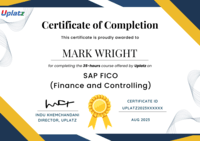Hotjar
Learn how to leverage Hotjar for user behavior analytics, heatmaps, feedback, and conversion optimization with hands-on projects. Price Match Guarantee
Full Lifetime Access
Access on any Device
Technical Support
Secure Checkout
Course Completion Certificate
Price Match Guarantee
Full Lifetime Access
Access on any Device
Technical Support
Secure Checkout
Course Completion Certificate
 96% Started a new career
BUY THIS COURSE (
96% Started a new career
BUY THIS COURSE (GBP 12 GBP 29 )-
 86% Got a pay increase and promotion
86% Got a pay increase and promotion
Students also bought -
-

- Digital Marketing & SEO
- 80 Hours
- GBP 12
- 3327 Learners
-

- Web Analytics
- 3 Hours
- GBP 12
- 86 Learners
-

- Product Management
- 2 Hours
- GBP 12
- 33 Learners

Understanding how users interact with your website or application is at the heart of great digital experiences. Hotjar – User Analytics and Feedback Tools is a comprehensive, self-paced course designed to equip marketers, UX designers, product managers, developers, and business owners with the knowledge and skills to visualize user behavior, collect meaningful feedback, and drive data-informed improvements.
As digital competition increases, understanding what users do—and why they do it—has become essential. Hotjar is one of the most powerful and intuitive tools for achieving this. Through a mix of behavioral analytics and direct user feedback, it helps teams uncover hidden friction points, improve conversion rates, and deliver exceptional user experiences. This course provides the step-by-step guidance you need to master Hotjar and apply its insights effectively across websites, e-commerce stores, and digital products.
What is Hotjar?
Hotjar is an all-in-one user analytics and feedback platform that combines multiple research tools into a single interface. It enables you to see how users navigate your site through heatmaps, session recordings, funnel analysis, surveys, and feedback widgets. Instead of relying only on numbers and charts, Hotjar provides visual and qualitative data to understand the real human behavior behind every click, scroll, and tap.
For example, you can see where users are spending the most time, where they stop scrolling, and which buttons get the most interaction. You can also replay real user sessions to spot confusion or hesitation points. When combined with user surveys and polls, Hotjar reveals why users behave a certain way, turning assumptions into evidence-based insights.
In this course, you’ll learn how to set up Hotjar from scratch, install tracking codes, configure your workspace, and start capturing real-time behavioral data. You’ll also explore advanced workflows that connect Hotjar data with other analytics tools for a complete, end-to-end understanding of user engagement.
How Does Hotjar Work?
Hotjar collects behavioral data from users as they interact with your website or application. This data is then visualized in easy-to-understand reports and heatmaps.
-
Heatmaps: Visual representations showing where users click, move, and scroll. They highlight what attracts attention—and what goes unnoticed—helping you refine layout and content placement.
-
Session Recordings: Real-time replays of user sessions that let you observe how people navigate, where they hesitate, and where they drop off.
-
Funnels: These track the stages of conversion (for example, from landing page → cart → checkout) to pinpoint where users abandon the process.
-
Surveys and Polls: Tools for collecting qualitative insights directly from users, revealing their motivations, frustrations, and preferences.
-
Feedback Widgets: Interactive on-site tools that allow users to rate their experience or share quick thoughts.
The course explains how these components work together to create a full picture of user behavior. You’ll also learn how Hotjar integrates with Google Analytics, HubSpot, and CRMs, bridging the gap between quantitative and qualitative analytics.
By combining data from multiple sources, you can make smarter decisions on UX improvements, marketing strategies, and content optimization.
How is Hotjar Used in the Industry?
Hotjar is widely used across industries—by e-commerce businesses, SaaS companies, startups, and digital agencies—to gain insights that fuel growth.
-
E-commerce Optimization: Retailers use Hotjar to analyze checkout abandonment, product page engagement, and purchase patterns. By understanding user behavior, they can streamline the buying process and boost sales.
-
UX and UI Design: Designers use heatmaps and recordings to validate design choices, test new layouts, and confirm whether design changes improve user journeys.
-
Product Management: Product teams rely on Hotjar to monitor feature adoption, gather in-app feedback, and prioritize updates based on real user needs.
-
Marketing and CRO (Conversion Rate Optimization): Marketers use Hotjar to track landing page performance, test A/B variations, and understand what drives conversions or drop-offs.
-
Customer Experience (CX): Businesses deploy surveys and feedback forms to capture real-time user opinions and improve satisfaction scores.
Global brands like HubSpot, Adobe, Shopify, and Decathlon use Hotjar to enhance digital experiences and guide decision-making. This course mirrors these real-world use cases, showing you how to translate Hotjar insights into tangible business outcomes.
Benefits of Learning Hotjar
Learning Hotjar is an investment in understanding people, not just data. The course empowers you to think like both an analyst and a user advocate.
Here’s what makes Hotjar essential for digital professionals:
-
Data-Driven Decisions: Instead of guessing what works, base every improvement on real behavioral data.
-
Enhanced User Experience: Identify pain points and redesign journeys to make them intuitive and enjoyable.
-
Improved Conversion Rates: Discover exactly why users drop off and implement fixes that increase engagement and sales.
-
Cross-Functional Collaboration: Hotjar insights benefit marketing, design, and product teams alike, fostering collaboration through shared visibility.
-
Fast and Non-Technical: Hotjar’s setup is beginner-friendly—no coding expertise required.
-
Career Relevance: With businesses increasingly valuing user-centric design and analytics, Hotjar proficiency adds measurable value to your digital career.
Whether you manage a website, product, or campaign, learning Hotjar ensures you can confidently interpret user behavior and lead optimization strategies.
What You’ll Learn
By the end of this course, you’ll have mastered the essential and advanced features of Hotjar. Through guided lessons and hands-on projects, you’ll learn to:
-
Analyze user journeys using heatmaps and click-tracking.
-
Use session recordings to identify usability problems and friction points.
-
Design and deploy on-site surveys and polls that gather actionable insights.
-
Optimize conversion funnels to reduce drop-offs and improve user flow.
-
Integrate Hotjar with Google Analytics, CRM tools, and marketing platforms for unified analysis.
-
Develop a repeatable framework for ongoing website and app optimization.
You’ll work on real-world scenarios—such as improving an e-commerce checkout flow or refining a SaaS onboarding process—so that your learning directly translates to professional application.
Who Should Take This Course
This course is designed for anyone who wants to make smarter, data-informed digital decisions:
-
UX/UI Designers – Validate design hypotheses and improve usability.
-
Digital Marketers – Increase conversions and engagement through behavioral analysis.
-
Product Managers – Understand user behavior to enhance feature adoption and retention.
-
Entrepreneurs & Startups – Optimize landing pages, user journeys, and funnels for faster growth.
-
Developers & Analysts – Support design and marketing teams with user-driven improvements.
No prior experience in analytics or coding is required. The course takes you from beginner to confident practitioner, ensuring that by the end, you can turn Hotjar insights into actionable business strategies.
Why This Course Matters
In the digital age, knowing how users behave on your website is just as important as knowing who they are. Numbers from Google Analytics show what is happening, but Hotjar shows why. This course bridges that gap—helping you transform raw interaction data into user empathy, better design, and higher business impact.
By mastering Hotjar, you’ll be able to combine data, psychology, and design thinking to continuously improve customer experience and business outcomes.
By the end of this course, you will be able to:
-
Implement Hotjar tracking and set up key features
-
Interpret heatmaps, click maps, and scroll maps
-
Analyze session recordings to diagnose usability issues
-
Deploy targeted surveys and polls for customer feedback
-
Use funnel analysis to identify drop-offs and improve conversions
-
Combine Hotjar insights with other analytics platforms for deeper insights
Course Syllabus
Module 1: Introduction to Hotjar
Module 2: Setting Up Tracking Scripts
Module 3: Heatmaps & Click Tracking
Module 4: Session Recordings & Analysis
Module 5: Designing Effective Surveys & Polls
Module 6: Conversion Funnel Optimization
Module 7: Integrating Hotjar with Other Tools
Module 8: Real-World Projects (Landing Page, E-commerce Flow, SaaS App)
Module 9: Interview Questions & Answers
Upon completion, learners will receive a Certificate of Completion from Uplatz validating their expertise in Hotjar and behavioral analytics.
Completing this course opens opportunities as:
-
Conversion Rate Optimization Specialist
-
UX Researcher
-
Digital Marketing Analyst
-
Product Analyst
1. What is Hotjar and what makes it unique compared to other analytics tools?
Answer: Hotjar is a behavior analytics and user feedback platform that provides insights through heatmaps, session recordings, surveys, and polls. Unlike traditional tools such as Google Analytics, which focus on quantitative data, Hotjar emphasizes qualitative insights—helping you understand the “why” behind user actions.
2. How do heatmaps work in Hotjar?
Answer: Heatmaps in Hotjar visually represent where users click, move, or scroll on a webpage. They aggregate user interactions into a color-coded map, showing areas of high engagement (hot spots) and low engagement (cold spots). This helps teams identify which parts of a page attract attention and which elements are being ignored.
3. What are session recordings, and how can they improve UX?
Answer: Session recordings capture real user interactions with your website, including clicks, taps, and scrolling behavior. By watching these recordings, teams can observe pain points such as confusing navigation or broken forms. This direct observation provides actionable data for improving user experience.
4. How does Hotjar help optimize conversion funnels?
Answer: Hotjar’s funnel analysis shows where users drop off during a process (e.g., checkout). By combining heatmaps and recordings, you can identify specific friction points, such as unclear CTAs or lengthy forms, and take corrective action to increase conversions.
5. Can Hotjar be integrated with other platforms? If yes, which ones?
Answer: Yes, Hotjar integrates with platforms like Google Analytics, HubSpot, Slack, Shopify, WordPress, and CRMs. These integrations allow teams to combine behavioral insights from Hotjar with quantitative data, marketing automation, or customer support systems.
6. What role do surveys and feedback polls play in Hotjar?
Answer: Surveys and polls allow businesses to gather direct input from users. They can be deployed on specific pages or triggered by user behavior. For example, a poll can ask users why they didn’t complete checkout, providing context that analytics data alone cannot reveal.
7. How does Hotjar ensure GDPR and privacy compliance?
Answer: Hotjar complies with GDPR by anonymizing keystrokes, masking sensitive data, and giving website owners the ability to suppress specific fields. Users can also opt out of tracking, ensuring data is collected ethically and securely.
8. What is the difference between Hotjar’s heatmaps and scroll maps?
Answer: Heatmaps show click and tap activity, while scroll maps indicate how far down a page users scroll. Scroll maps help determine whether key content is placed too low on a page, where users may never see it.
9. What challenges might you face when using Hotjar?
Answer: Challenges include limited sample sizes (depending on the plan), potential bias in survey responses, and the need to combine Hotjar insights with other data sources. Overreliance on qualitative data without context may also lead to misinterpretation.
10. How would you use Hotjar in an e-commerce optimization project?
Answer: In e-commerce, Hotjar can be used to analyze checkout heatmaps, watch session recordings of abandoned carts, and trigger exit-intent surveys asking why users didn’t complete purchases. Insights can then guide changes like simplifying forms, adjusting CTA placements, or improving mobile responsiveness.









